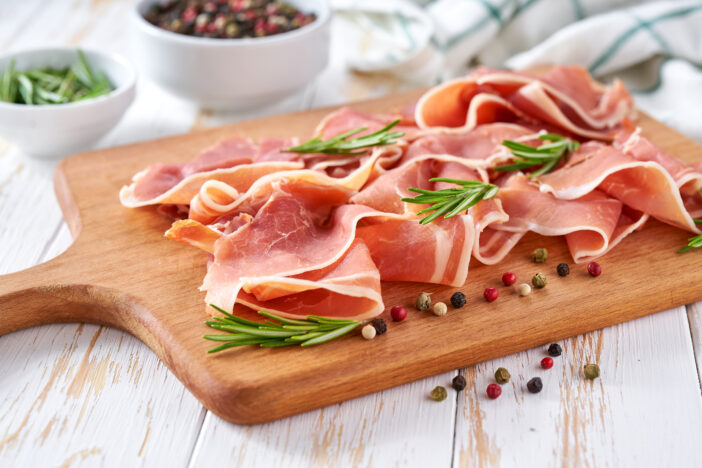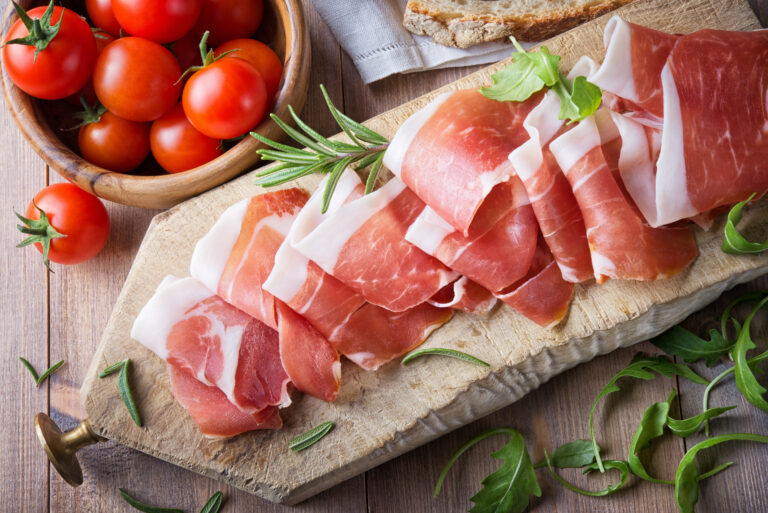7 Differences Prosciuttini vs Prosciutto You Need to Know
Prosciuttini and prosciutto: Dive into the differences and origins of these Italian cured meats, exploring their flavors, production processes, and culinary uses.

You might think you know your Italian cured meats, but the subtle differences between prosciuttini and prosciutto can surprise even seasoned foodies. Let’s delve into what sets these two delicacies apart and why each deserves a spot on your charcuterie board.
Disclosure: As an Amazon Associate, this site earns from qualifying purchases. Thank you!
Exploring the Origins of Prosciuttini and Prosciutto

Delve into the rich history of these Italian delicacies to better appreciate their culinary significance.
Prosciutto
Prosciutto, known for its delicate aroma and sweet taste, dates back to ancient Roman times. Originally preserved with salt, it was crucial for year-round consumption. The term “prosciutto” derives from the Latin “perexsuctum,” meaning “dried out,” highlighting its preparation method. Regions like Parma and San Daniele uphold strict traditions, influenced by unique climates that shape their distinct flavors, making prosciutto a cultural icon in Italian cuisine.
Prosciuttini
Prosciuttini, a variation of prosciutto, incorporates spices like black pepper, nutmeg, and occasionally garlic during curing. It evolved locally to accommodate diverse regional tastes and utilize different pork cuts efficiently. This spiced counterpart has found popularity in specific Italian communities and internationally, appreciated for its robust flavors.
These insights illuminate how prosciutto and prosciuttini have evolved from ancient preservation methods to become cherished elements of Italian culinary heritage.
Analyzing the Production Processes

The crafting techniques of Italian cured meats, prosciuttini, and prosciutto, highlight a blend of traditional and regional flavor adaptations. Let’s delve into how each is made.
How Prosciutto is Made
- Selection of Meat: Typically made from the hind legs of pigs, the initial selection of meat in prosciutto production is crucial. Premium breeds like the Italian Large White, Landrace, or Duroc are often chosen for their superior quality and fat distribution.
- Salting: The legs are then salted and left to rest in controlled environments. This step is key to prosciutto’s unique flavor and texture, removing moisture and preserving the meat.
- Resting and Washing: After salting, the legs are rested for several weeks and then thoroughly washed to remove excess salt.
- Aging: The aging process, which can last from 12 to 36 months, is what truly defines prosciutto. The longer it ages, the more intense and refined the flavor. Aging occurs in well-ventilated rooms that mimic the natural climatic variations of the region.
- Quality Control: Before being sold, each piece undergoes rigorous quality checks to ensure it meets the high standards expected of authentic prosciutto.
Prosciuttini Production
- Seasoning: Unlike prosciutto, prosciuttini involves a rich mix of spices such as black pepper, nutmeg, and sometimes cloves or cinnamon during the initial processing. These seasonings are applied along with salt to create its distinctive spiced flavor profile.
- Curing Process: Prosciuttini is then cured, which involves both drying and aging but typically for a shorter period than prosciutto. The spice-infused meat undergoes a more accelerated curing process, lasting about three to six months.
- Smoking: Unique to prosciuttini, the meat often undergoes a smoking phase using various kinds of wood, which imparts additional flavors and helps in the preservation process.
- Final Preparation: After curing and smoking, prosciuttini is also subject to quality checks. This process ensures the flavors are well-balanced and that the meat maintains its intended quality and texture.
Understanding these processes sheds light on why these meats hold their revered places on charcuterie boards and in Italian culinary tradition. Each step in their production underlines the dedication to quality and tradition, making them stand out in gastronomy.
Comparing Taste and Texture

After understanding the meticulous craft behind prosciuttini and prosciutto, it’s crucial to dive into how these processes influence their taste and texture. Here’s how each stands out on your palette.
The Flavor Profile of Prosciutto
Delve into the world of prosciutto, and you’ll find a taste that’s as rich as its history. Prosciutto’s flavor profile is delicate yet distinct, embodying a sweet, buttery taste that slowly melts in your mouth. This complexity is largely due to the lengthy aging process, typically up to 36 months, which intensifies the meat’s flavor while maintaining its tenderness. The taste is subtly enhanced by the natural salting which draws out moisture, concentrating the pork’s natural flavors.
What Makes Prosciuttini Distinct
Contrarily, prosciuttini offers an entirely different sensory experience. This meat is seasoned with a blend of robust spices, including black pepper and nutmeg, which injects an immediate burst of flavor noticeable upon the first bite. The addition of smoke during the curing process adds a rich, woody undertone that complements the spice-infused profile. Due to its shorter curing time compared to prosciutto, prosciuttini has a firmer texture and a bolder, more assertive flavor, making it a standout on any charcuterie board.
Nutritional Values and Health Benefits

Delve into the nutritional nuances and health rewards of these popular Italian cured meats.
Examining the Nutritional Content in Prosciutto
Prosciutto is celebrated not just for its taste but also for its nutritional profile. Rich in high-quality proteins, it provides about 18 grams per 2-ounce serving. It’s also a good source of vitamins and minerals, including B vitamins, particularly vitamin B12 which is essential for red blood cell production and nerve health. However, it’s also high in sodium, with roughly 2,000 milligrams per serving, making it a treat best enjoyed in moderation.
Health Benefits of Incorporating Prosciuttini in Your Diet
Prosciuttini, with its distinct flavor profile, also brings several health benefits when consumed responsibly. Like prosciutto, it’s high in protein which can aid in muscle repair and growth. The smoking process used in prosciuttini’s production introduces potent antioxidants that may help combat oxidative stress in your body. Moderation is key, however, as prosciuttini can also be high in sodium. Enjoy it in small amounts to add a burst of flavor and nutrients to your meals without going overboard on salt intake.
Culinary Uses and Popular Recipes
Both prosciuttini and prosciutto bring unmistakable flavors to various dishes, enhancing your cooking with their unique characteristics.
Traditional Dishes Using Prosciutto
- Wrap it Around Melon: Start with a classic Italian appetizer. Prosciutto wrapped around slices of cantaloupe offers a perfect balance of savory and sweet flavors.
- Enhance Your Pasta: Elevate a simple Aglio e Olio by tossing in torn strips of prosciutto just before serving. The fat melts slightly, adding depth to the dish.
- Top on Pizzas: Add Prosciutto after baking for a sophisticated touch on your homemade pizzas. It pairs well with arugula and a drizzle of balsamic reduction.
- Stuff into Chicken: Create a stuffed chicken breast by incorporating prosciutto along with cheese and herbs for a juicy, flavorful entrée.
- Spice Up Breakfast: Substitute prosciuttini for regular bacon in your breakfast dishes. Its smoky flavor will enhance omelets, scrambles, and breakfast sandwiches.
- Stir into Risottos: Dice prosciuttini and add it to risotto. The meat’s robust flavor infuses throughout the creamy rice, offering bursts of smokiness.
- Incorporate into Stews: For a heartier dish, add chopped prosciuttini to bean stews or winter vegetable soups. Its spices complement the natural sweetness of root vegetables.
- Make a Deli Sandwich: Layer slices of prosciuttini with your favorite cheeses and a sharp mustard on rye bread for a lunch that packs a flavorful punch.
Purchasing Tips: Buying Prosciuttini and Prosciutto

After exploring the rich flavors and diverse culinary uses of prosciuttini and prosciutto, it’s essential to know where to buy these Italian cured meats and how to select the best quality.
Where to Find Quality Prosciutto
Finding high-quality prosciutto can enhance any dish, whether it’s wrapped around melon or incorporated into a luxurious pasta. Here are locations where you can find premium prosciutto:
- Specialty Italian Stores: These shops often source authentic prosciutto directly from Italy, ensuring you get a product steeped in tradition.
- High-End Supermarkets: Look for prosciutto in the deli section of upscale grocery stores where turnover is high, ensuring freshness.
- Online Gourmet Retailers: Websites like D’Artagnan and Gourmet Food Store offer a variety of prosciutto grades, including DOP-certified options, delivered right to your door.
- Local Farmers Markets: Some local producers might offer artisanal versions of prosciutto, emphasizing a farm-to-table approach.
Selecting Quality
- Check the Ingredients List: Quality prosciuttini should contain no filler ingredients like corn syrup or excessive preservatives. Look for simple, natural ingredients.
- Examine the Texture and Color: Ideal prosciuttini should have a firm texture and a consistent color throughout. Avoid products with discoloration or dry edges.
- Smell Before Buying: Prosciuttini should have a bold, rich aroma without any off-putting smells. A strong smoky scent is a good indicator of traditional smoking processes.
- Ask for Samples: If possible, taste a sample before purchasing. This taste test can help you gauge the saltiness and overall flavor profile, ensuring it meets your expectations for culinary use.
Frequently Asked Questions
What are the main differences between prosciuttini and prosciutto?
Prosciuttini and prosciutto are both Italian cured meats but differ primarily in flavor and production methods. Prosciuttini is known for its bold, assertive taste and often has added spices, whereas prosciutto is celebrated for its delicate, buttery flavor, resulting from a traditional curing process that involves fewer spices.
Why are prosciuttini and prosciutto important on charcuterie boards?
Prosciuttini and prosciutto add rich flavors and textures to charcuterie boards, enhancing the overall dining experience. Their contrasting flavors provide a variety of taste profiles that can cater to different palates, making the board more appealing and diverse.
How do the production processes of prosciuttini and prosciutto influence their taste?
The production processes of these meats greatly influence their taste. Prosciutto’s production involves a longer curing time with less spice, which results in a milder, buttery flavor. Prosciuttini, on the other hand, includes additional spices and a different curing technique that gives it a more robust flavor.
What are some recommended dishes that include prosciuttini or prosciutto?
Both types of meat are versatile in culinary uses. Recommended dishes for prosciutto include wrapped melon, prosciutto cotto sandwiches, and as a refined addition to salads or pizzas. Prosciuttini works well in robust, flavorful dishes like antipasto platters, and stuffed meat recipes, and paired with stronger cheeses.
Where can I buy quality prosciuttini and prosciutto?
Quality prosciuttini and prosciutto can be found at specialty Italian stores, high-end supermarkets, online gourmet food retailers, and local farmer’s markets. It is important to look for quality indicators like the ingredients list, proper texture, natural color, and a fresh smell. Tasting a sample can also be a good strategy to ensure the flavor meets your expectations before purchase.
What should I look for when purchasing prosciuttini or prosciutto?
When purchasing these cured meats, check for a short ingredient list, indicating fewer preservatives and additives. The texture should be firm yet tender, the color should be natural and uniform, and the smell must be fresh. Optionally, tasting a sample can help confirm the quality and flavor suitability for your dishes.






